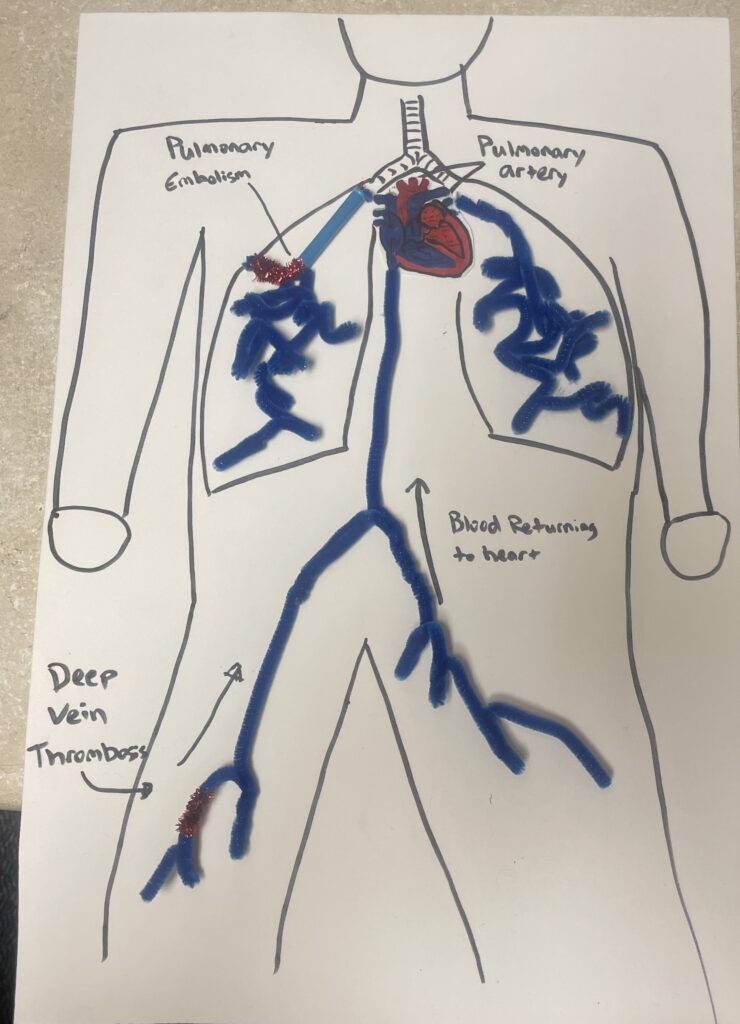I chose to do my project on deep vein thrombosis and some effects it has on the human body and also some treatments. My project depicts the veins and blood clots using straws and pipe cleaners to better visualize what is happening.
Written project
Blair Coomer
Biol F112X
4/19/24
Effects of Pulmonary Embolism
Abstract
My Project will be covering the mechanism and effects of a pulmonary embolism. Deep vein thrombosis is also a big component that creates pulmonary embolism. Pulmonary embolism is a serious medical condition that can lead to death depending on how big the clot is and how long it has been left untreated. The objectives I will be covering will be Identifying components of blood, how the human binds and releases O2 and CO2, and the circulatory system from the heart to the lungs.
Pulmonary embolism is a blood clot in one of the arteries or fills up multiple arteries in the lungs. It is a cause of death for 300,000 Americans annually. In most cases roughly 79% of patients this is a result of deep vein thrombosis. Deep vein thrombosis is a blood clot in the deep veins in lower extremities commonly in the calf. It can be caused by a family history with it, smoking, obesity, cancer, smoking, cancer, heart failure, birth control, after surgeries, and immobility. Some signs and symptoms of deep vein thrombosis are swelling in the leg, pain around the area, warmth around the area, and discoloring. The blood clot in deep vein thrombosis occasionally comes loose and makes its way to a proximal vein and then travels back to the heart. The clot gets pumped through the heart and into the pulmonary artery and into the lungs where it will get stuck somewhere when the veins start to get smaller. This can also cause tension in the right ventricular wall which causes dysfunction, dilation and ischemia of the right ventricle where death can then occur. Some signs and symptoms that you may have a mild Pulmonary embolism is chest pain, cough, palpitations, lightheadedness, fever, wheezing, and rales in the lungs. Some signs and symptoms of a major clot will include cardiac arrest, syncope, hypotension, and hypoxemia. A pulmonary embolism is a serious complication and has a high mortality rate and needs medical attention right away.
Treatments for a mild pulmonary embolism includes taking heparin or warfarin which is an anticoagulant. “Heparin binds to and accelerates the activity of antithrombin III, prevents additional thrombus formation, and permits endogenous fibrinolytic mechanisms to lyse clot that has already formed.” -science direct article. This will not dissolve the clot but will make it so the clot does not build up.
Treatments for more serious cases will include catheter directed thrombolysis. In this procedure they put a catheter into the femoral vein and make their way up through the heart and to the clot site in the lungs with guidance from an x-ray. Then they will administer a bolus of thrombolytic drugs to break up the clot. Another way they can get rid of the drug is again using a greenfield embolectomy device to use suction and manually take the clot out.
Ways you can prevent pulmonary embolism is to prevent deep vein thrombosis. To prevent deep vein thrombosis you can move around more instead of sitting for long periods of time, exercise, maintain weight,take medications regularly, quit smoking, and have a healthy lifestyle.
Works cited
Acute Pulmonary Embolism | Nejm. https://www.nejm.org/doi/full/10.1056/NEJMra072753.
Author links open overlay panelRenan Uflacker MD, et al. “Interventional Therapy for Pulmonary Embolism.” Journal of Vascular and Interventional Radiology, Elsevier, 16 Apr. 2007, https://www.sciencedirect.com/science/article/abs/pii/S1051044307618211.
“Pulmonary Embolism.” Pulmonary Embolism | Johns Hopkins Medicine, 8 Aug. 2021, https://www.hopkinsmedicine.org/health/conditions-and-diseases/pulmonary-embolism#:~:text=Risk%20factors%20for%20pulmonary%20embolism,the%20legs)%20or%20orthopedic%20surgery.


Blair chose to do her project on pulmonary embolism, and depicted this with a lot of information and a poster depicting the map of blood veins. Her project uses pipe cleaners to mimic the veins in the body, using blue as it is the usual color of veins in anatomical models. She specifically uses red metallic pipe cleaners to show blood clots and their location in the body. This is a really creative way to show pulmonary embolism using a 3D art style to depict it.
Pulmonary embolism is also known as blood clotting, and this occurs when arteries and veins are clogged with platelets. They typically appear in the legs, being placed very deeply in the veins there. It can be caused by many things such as; cancer, smoking, obesity, or heart failure.
Treatments can consist of medication like warfarin or heparin to “de-clog” the veins. This won’t completely fix the clot, but it will stop the clot from building up. Prevention can be regular exercise, weight maintenance, and an overall healthier lifestyle.